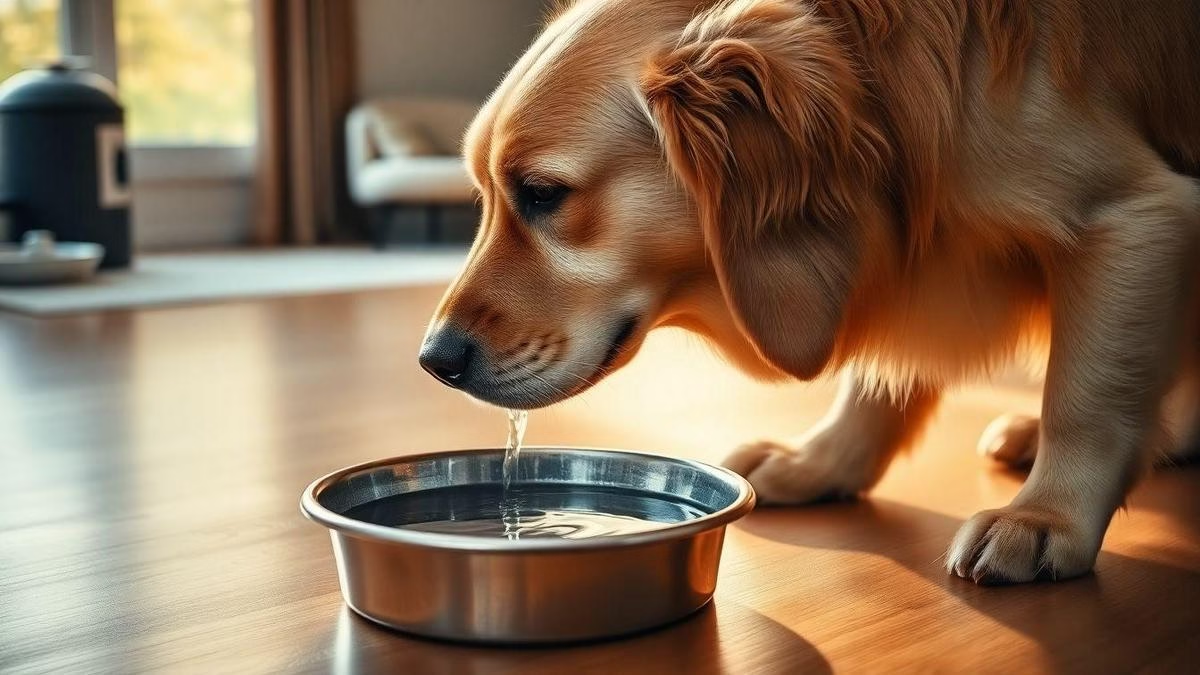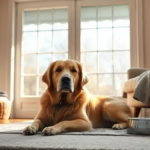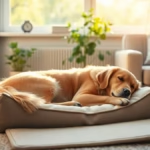I know caring for an older golden can feel worrying. I watch for dehydration by checking signs of dehydration such as dry gums, sunken eyes, low saliva, lethargy, less pee, and skin tenting so I can act fast. I use simple at-home checks, a gentle daily routine, timed water breaks, and I bring water on walks. I pick shallow, wide bowls and a quiet fountain for my picky drinker, add hydrating wet food, and always talk to my vet before supplements. I track weight, urine color, and appetite, and I use low-sodium broth, ice cubes, and extra water stations to make drinking easy and enjoyable.
Key Takeaway
- Keep fresh water available and change it daily.
- Place extra bowls where your dog rests.
- Add a splash of low-sodium broth to tempt drinking.
- Use a shallow, non-slip bowl to make drinking easier.
- Track water intake and call your vet if it changes significantly.
How I spot signs of dehydration in my senior golden retriever
Hydration Tips for Senior Golden Retrievers: Encouraging Water Intake starts with noticing small changes. My ten-year-old shows needs in quiet ways: a heavy sigh beside his bowl, dull coat, slower movement. I trust simple clues—gums, eyes, energy—and sometimes keep a short water journal for a few days to spot trends (part of a healthy routine). Those tiny checks let me catch problems early.
Noting dry gums, sunken eyes, and low saliva
I gently check his gums (color and moisture) and compare photos on my phone so I remember his normal look. If gums feel tacky or pale, or his eyes seem sunken and he drools less, I offer cool water, shade, and call the vet if he doesn’t improve.
Watching for lethargy, reduced urine output, and skin tenting
A loss of enthusiasm—less wagging, longer naps—paired with fewer trips outside or slow skin-tent return are red flags. I hydrate him gently, note the change, and consult the vet if things don’t bounce back quickly.
Simple at-home checks I use
- Check gums for color and moisture.
- Look for sunken eyes or reduced saliva.
- Note urine frequency and color.
- Do a skin tent test over the shoulder.
- Offer cool water and see if he drinks willingly.
- Weigh weekly to spot slow fluid loss. Call the vet if multiple checks are off.
My daily schedule to encourage water intake
I set up small moments for water all day—many tiny chances to sip rather than one big refill.
| Time of day | Action | Goal (approx.) |
|---|---|---|
| Wake-up | Fresh bowl optional low-sodium broth | 50–100 ml |
| Mid-morning | Top-up after a short walk | 30–60 ml |
| Lunch | Wet food or moistened kibble | encourages sipping |
| Afternoon | Refill near nap spot clink cue | 30–60 ml |
| Evening | After play and before bed | 50–100 ml |
Setting timed water breaks
I use phone alarms every 2–3 hours to prompt water breaks and give a soft cue (bowl clink, drink time) so he learns the routine. If he skips a scheduled drink, I check gums, energy, and appetite and note it.
- Morning alarm — fresh bowl and optional broth
- Mid-morning — short walk then water break
- Lunch — wet food or moistened kibble
- Afternoon — quiet refill near resting spot
- Evening — after play and before bed refill
Bringing water on walks and after play
I never leave without a small bottle and a collapsible bowl. He drinks better from his own bowl than cupped hands. Offer water halfway through walks and again after finishing to avoid gulping and keep drinking natural. Praise softly when he sips; if reluctant, mix in a little broth or wet-food bites. On hot days I follow summer care tips—shorter walks, shaded rests, and more frequent drinks.
How I chose the best water bowls and fountains for my picky senior
Hydration Tips for Senior Golden Retrievers: Encouraging Water Intake includes choosing the right dish. I tested materials, heights, and locations and settled on a low, wide ceramic bowl for meals and a quiet fountain for grazing. The fountain kept water fresher; the bowl reduced neck strain.
Picking shallow, wide bowls
Shallow, wide bowls reduced whisker stress and neck strain. I avoided plastic (odors, irritation), and chose stainless steel or ceramic for easy cleaning and cooler water.
Trying a quiet water fountain
A low-noise fountain with replaceable filters got him curious and drinking during the day. Balance a fountain with a bowl—some dogs prefer one over the other.
Features I look for
- Low, wide rim to reduce neck strain and whisker stress
- Non-porous material (stainless steel or ceramic)
- Non-slip base so the bowl stays put
- Quiet pump and simple filter system for fountains
- Easy disassembly for weekly cleaning
| Item | Best for | Notes |
|---|---|---|
| Shallow, wide bowl | Mealtimes and seniors with neck pain | Simple, cheap, easy to clean |
| Quiet fountain | Dogs who prefer moving water | Keeps water fresh but needs weekly care |
For ideas on useful gear and placement, I reviewed recommended equipment and supplies and adapted spots in my home.
How I added hydrating wet food and safe supplements
When he drank less and lost weight, I added small amounts of low-sodium wet food and vet-approved supplements. Hydration Tips for Senior Golden Retrievers: Encouraging Water Intake includes moistened kibble and warm broth to boost fluids and aroma.
| Addition | What it does | Typical amount I use |
|---|---|---|
| Canned wet dog food (low sodium) | Adds moisture and aroma | 1–2 tbsp per 1 cup kibble |
| Warm low-sodium chicken broth | Boosts fluid and smell | 1–3 tbsp per meal |
| Plain pumpkin | Adds texture and aids digestion | 1 tsp–1 tbsp |
| Fish oil (vet ok) | Supports coat and inflammation | Vet dose |
Mixing wet food with dry kibble
Start slowly—e.g., 1:4 wet-to-dry, move toward 1:2 if tolerated. Mash wet food to coat kibble and warm slightly to increase smell and encourage licking and sipping. For more ideas to make meals appealing, see creating appetizing meal experiences and practical ways to stimulate appetite in picky seniors.
Discussing supplements with my vet
Always clear supplements with the vet, check for medication interactions, and introduce one new supplement at a time. We agreed on periodic bloodwork to monitor organ function.
Simple recipe and supplement rules
Mix 1 cup kibble with 2 tbsp wet food 1 tbsp warm low-sodium broth; add vet-approved fish oil if cleared. Introduce changes slowly, avoid garlic/onion, and stop any new item if stool or energy dips.
Working with my vet to monitor and prevent dehydration
I treat my vet as a teammate—sharing a short daily log of water times and amounts, appetite, and stool. We agreed on thresholds for testing and action (bloodwork, urinalysis, electrolytes) and schedule checkups every six months or sooner if needed. For broader guidance on routine medical care, I follow recommendations for essential veterinary care.
What I bring to visits
- Recent water log and notes on appetite
- Any medications or supplements (in bottles)
- A photo of recent urine color if possible (helpful when ruling out kidney issues like those discussed in kidney-problem guides)
- Questions written down
Tracking weight, urine color, and appetite
I weigh my dog every few weeks and check urine color after walks. Changes in weight or appetite can precede larger problems.
| Urine Color | What it often means | What I do |
|---|---|---|
| Pale straw to light yellow | Normal | Continue usual care |
| Dark yellow | Mild dehydration/concentrated urine | Offer extra water, wet food or broth |
| Orange or brown | Possible liver issue or severe dehydration | Contact vet same day; consider screening for kidney or liver problems via professional evaluation |
| Cloudy or bloody | Infection or serious problem | Take sample to vet now |
Urgent signs I report immediately
Very dry gums, sunken eyes, collapse, persistent vomiting, very little/no urine, sudden weakness, shaking, or confusion — call the vet or go to the clinic right away.
How I enrich water time to make drinking fun
Hydration Tips for Senior Golden Retrievers: Encouraging Water Intake became my daily motto. I treat water time as a pleasant pause: a splash of low-sodium broth, ice cubes on hot days, or a fresh bowl in a quiet corner. Little changes—consistent and kind—made him check his water spots like clockwork.
Using low-sodium broths and ice cubes
I use plain low-sodium chicken broth (no onions/garlic), a tablespoon in the bowl or frozen into cubes to melt slowly. For dogs with kidney or other health issues, always check with your vet first. For hot-weather strategies and safe cooling, I factor in summer care tips.
Placing multiple stations around the house
I set up three stations—near his bed, by the back door, and where I sit—using different bowls (ceramic, stainless, fountain). Refill and clean twice daily. If he struggles to reach one, I move a bowl closer temporarily; this is part of how I adapt our home to his needs.
Gentle behavior steps to build a lasting drinking habit
- Offer a cue (soft call or tap)
- Add a gentle flavor if needed (small broth splash or ice cube)
- Praise calmly when he drinks
- Refill and clean bowls twice daily
- Move a station closer if he struggles to get up
Conclusion
Watching a senior Golden slow down is emotional. Hydration Tips for Senior Golden Retrievers: Encouraging Water Intake boils down to simple, steady steps: keep fresh water always available, set up multiple stations, use shallow, wide bowls or a quiet fountain, and monitor small signs—dry gums, sunken eyes, lethargy, and changes in urine color. Timed breaks, a splash of low-sodium broth, wet food, and carrying water on walks create many tiny oases through the day. Log weight, appetite, and water intake, and work with your vet early and often.
Little changes—consistent and kind—add up to big gains for an older dog’s comfort and health. For more practical tips and gentle tricks, see everyday joys with my senior Golden.

Rafael Souza is a digital marketing strategist and lifelong dog enthusiast. Passionate about Golden Retrievers, he shares practical, research-based tips to help owners provide healthier and happier lives for their furry companions.





